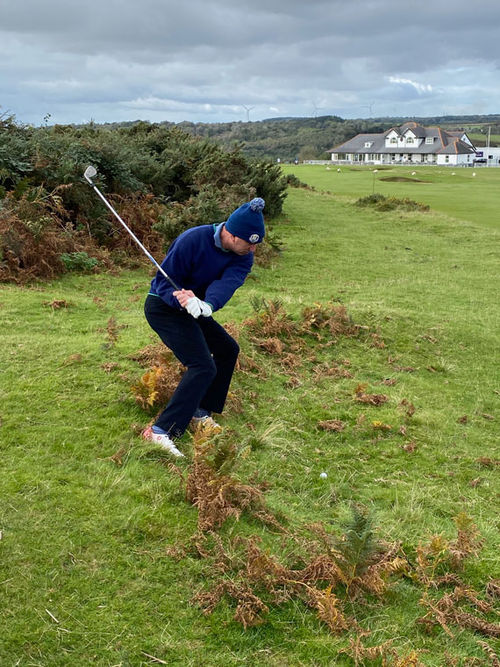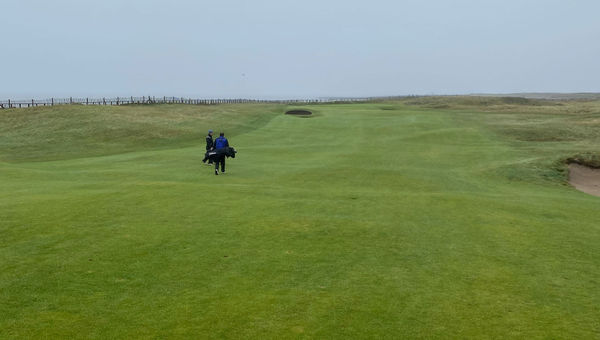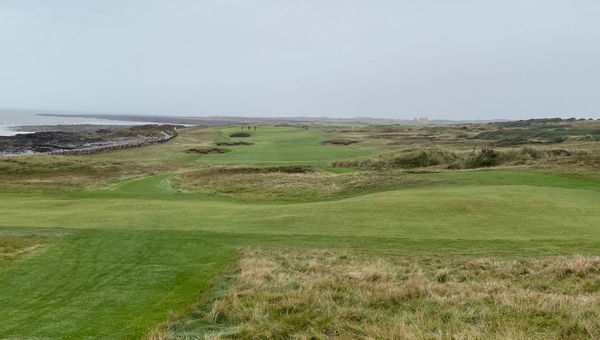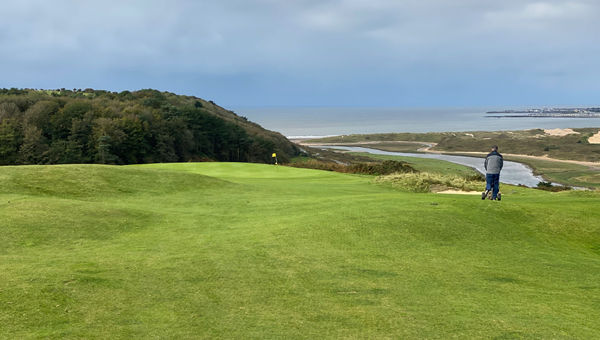Brilliant!
It's a very British word to be sure. But as I stared from 175 yards toward the second green of Royal Porthcawl golf course, that was the word that came to my American mind.
Just to the left of the green and beyond lay the Bristol Channel. Beautiful but foreboding to the golfer's eye, my first inclination was to aim safely to the right of the flag. The beach is a great place to go, unless you're golfing.

On the 18th hole at Southerndown, Robert Silk tries to hit his ball from a precarious lie. Photo Credit: Ian Wilson
But then my focus shifted toward the deep, gaping bunker that sits immediately to the right of the green, ready to swallow even a slightly errant shot. Playing from there, I realized, would be a terrifying prospect. Meanwhile, between me and the green was a series of humps and hollows with the appearance of a moonscape that mostly tilted left to right.
My only choice, I realized, was to aim left of the hole, perilously near the out of the bounds fence that separates golf course from beach, in order to give my ball room to take the expected rightward bounce off the firm turf and still not get engulfed by that ghastly bunker.
Wow, I thought. What a golf hole!
For many passionate golfers from the U.S, and indeed around the world, the seaside links courses of Great Britain and Ireland are a sort of mecca. Golf's home is regarded as Scotland, and more specifically the Old Course of St. Andrews, which sits hard along the North Sea on Scotland's east coast.
Meanwhile, Ireland sports a slew of renowned seaside courses, including Royal County Down in Northern Ireland, which was recently ranked by Golf Digest as the best course in the world.
But while Scotland and Ireland have successfully turned their old-style golf courses into tourism cash cows, few foreigners think to travel to Wales' seaside links courses. That's something Visit Wales is hoping to change.
Last week, Celtic Manor Resort in Newport played host to the International Golf Travel Market. The event gave Wales tourism promoters an opportunity to show off the country's courses to a targeted audience of destination golf tour operators -- the types of buyers that so often send clients to Scotland and Ireland. There to cover the conference, I got a small taste of Wales golf. I'd love to go back for more.

Walking toward the green on the second hole at Royal Porthcawl. Photo Credit: Robert Silk
The country of just 8,000 square miles boasts 26 seaside links courses. Royal Porthcawl, which Golf Digest ranks among the top 50 golf courses globally, is the most prestigious. The second course I played, nearby Southerndown, is also ranked among Wales' best.
The fairway is also a pasture
The first thing I noticed when I pulled into Southerndown, however, was the sheep. The course is on land with commonly owned pasture rights that date back centuries, and sheep grazed just off the putting green, just as they did on numerous holes throughout the course.
It might sound obtrusive, but it wasn't. Indeed, the sheep added character to the round, serving as a reminder that golf in Wales, just as at the many courses I've been fortunate to play in Scotland and Ireland through the years, is more relaxed than the golf we know in the U.S.
Thoughts of sheep, however, quickly give way to the golf itself. The course sits on a rolling sand-based landscape high above the Bristol channel, offering splendid views throughout as well as the usual challenges and charms of links golf, including ever-present winds; scary, golf ball-eating gorse bushes just off the fairways; tiny pot bunkers; and sharply breaking greens.

A gorgeous view from the tee on the first hole at Royal Porthcawl. Photo Credit: Robert Silk
On the par-4 second hole, a downhill second shot is played toward a green perched cliffside, with the sea behind in the distance. The par-5 sixth, perhaps my favorite hole on the course, is a gently sloping uphill hole. Lined by bracken and gorse on both sides and studded with beautifully defined bunkers, it oozes character.
No. 8, a long, downhill par-3, is so wind-affected that one of my playing partners, a Southerndown member named Ian Wilson, told me that he has hit everything from a driver to a pitching wedge off that tee.
Porthcawl, like Southerndown, occupies bumpy, other-worldly terrain. But it sits immediately adjacent to the sea. The Bristol Channel, in fact, is in view on every hole, and the first three holes play directly alongside it. On the 18th, golfers play downhill to a green backed by the surf.
After golf legend Tom Watson first played Porthcawl in 2014, his reaction was as straightforward as it was ebullient.
"It was just one great hole after another," he said.
Rain is part of the experience
I played Porthcawl in a sometimes driving rain. It was, after all, October in the U.K.. But soaked though I was, I never considered quitting, even when shirt and trousers got soaked through, despite the rain suit I was wearing on top of them. The course was too special.
The following day, Jason Thomas, head of Visit Wales, even sought to turn the rain to into an asset.
"I think to play sometimes in the rain in Wales is to really, truly feel alive," he said, sparing no hyperbole. "We all play golf sometimes in the nice weather in our shorts, but until you've got a bit of rain beating down on your waterproof stack, that's real golf to me."
Thomas also emphasized the friendly and welcoming nature of Welsh golfers, which was something I experienced first-hand at Southerndown later in the week. That day, I was about to play alone when Wilson and fellow club members Neil McGrath, hearing my American accent, invited me to join their game.

The second hole at Southerndown features a dangerous approach and broad views of the Bristol Channel. Photo Credit: Robert Silk
For the following three-plus hours they offered advice, local knowledge and even a bit of flattery as we toured the rugged links.
Oh, and about that approach on No. 2 at Royal Porthcawl. My seven iron shot flew high and straight. It landed about 10 yards in front of the green and bounced forward and right before coming to rest on the green, about 30 feet from the hole and perhaps 10 feet left of that horrifying pot bunker.
I exhaled and breathed a happy sigh of relief.